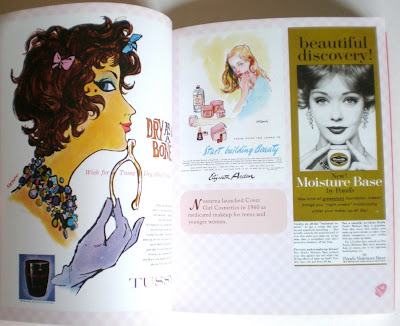A World of Costumes in Cutout
Hello Gorgeous!
70's Fashion Fiascos
Encyclopedia of World Costume
Dressing the Part
History of Costume
Fashion: The Changing Shape of Fashion Through the Years
If you read this blog, you probably have more than a passing interest in vintage fashion or costume history. Collecting a good library of books is essential for inspiration, dating, and general research into fashion eras. The following books are a few good ones. Some are recent publications, one is over 50 years old. They all 'stand up' to the test: nice to look at, with good information.
 A World of Costume in Cutout is colorful and well illustrated. This paperback book is designed to be cut up and made into standing paper dolls arranged in scenic rooms. The fashion illustrations show historical examples in gorgeous color, making it hard to even think of cutting up this book's pages.
A World of Costume in Cutout is colorful and well illustrated. This paperback book is designed to be cut up and made into standing paper dolls arranged in scenic rooms. The fashion illustrations show historical examples in gorgeous color, making it hard to even think of cutting up this book's pages. Hello Gorgeous is a tiny book, packed with terrific full color beauty ads from the 1940's, 1950's and 1960's. It is a great resource for graphic artists, fashion historians and those who love vintage fashion or want to re-create their own vintage look in hair and makeup.
Hello Gorgeous is a tiny book, packed with terrific full color beauty ads from the 1940's, 1950's and 1960's. It is a great resource for graphic artists, fashion historians and those who love vintage fashion or want to re-create their own vintage look in hair and makeup. 70s Fashion Fiascos is full of great color photos from apparel catalogs of the 1970's. This includes shoes and other accessories, as well as amazing photos of men's wear during that decade (did they really look like that?). Whether you collect or wear vintage, design fashion or costumes, this little book is a must for your bookshelf.
70s Fashion Fiascos is full of great color photos from apparel catalogs of the 1970's. This includes shoes and other accessories, as well as amazing photos of men's wear during that decade (did they really look like that?). Whether you collect or wear vintage, design fashion or costumes, this little book is a must for your bookshelf. Encyclopedia of World Costume is an excellent book to use when looking for ideas, dating something, designing costume or fashion. The illustrations are line drawings with lots of great details. If you ever watched a movie and wondered about the costume era, this book will help you find that information. It is arranged by alphabetic topic, rather than historical order.
Encyclopedia of World Costume is an excellent book to use when looking for ideas, dating something, designing costume or fashion. The illustrations are line drawings with lots of great details. If you ever watched a movie and wondered about the costume era, this book will help you find that information. It is arranged by alphabetic topic, rather than historical order. Dressing the Part was published in 1950 as a revision to a 1938 costume history book. It has excellent information on historical costume for the costume designer, with special references on the era itself. The early 20th century section is a first hand account. It is illustrated with black line drawings, a reminder of the days when every costumer had to sketch her own drawings by hand. The author was the costumer at the famed Pasadena Playhouse during its golden years, so this is a sought after volume.
Dressing the Part was published in 1950 as a revision to a 1938 costume history book. It has excellent information on historical costume for the costume designer, with special references on the era itself. The early 20th century section is a first hand account. It is illustrated with black line drawings, a reminder of the days when every costumer had to sketch her own drawings by hand. The author was the costumer at the famed Pasadena Playhouse during its golden years, so this is a sought after volume. History of Costume was for many generations of costumers their bible. It has gorgeous line drawings, with occasional black and white photos of actual garments of the period. Collect this and you will have one of the best respected books on historical costume available.
History of Costume was for many generations of costumers their bible. It has gorgeous line drawings, with occasional black and white photos of actual garments of the period. Collect this and you will have one of the best respected books on historical costume available. Fashion, The Changing Shape of Fashion Through the Years:
Fashion, The Changing Shape of Fashion Through the Years: Published in the 1970's, this book is illustrated with color and black and white photos, many from the 60's and 70's. Original paintings from historical eras are included, which give excellent examples of how fashion was worn by real people. This is a great book for anyone who wants to build their understanding of historical fashion: costumer, fashion designer or vintage fashion collector.
BOOK LIST
A World of Costumes in Cutout, Lowndes and Kailer
Hello Gorgeous, Rachel C. Weingarten
70's Fashion Fiascos, Maureen Valdes Marsh
Encyclopedia of World Costume, Doreen Yarwood
Dressing the Part, Fairfax Proudfit Walkup
History of Costume, Blanche Payne
Fashion: The Changing Shape of Fashion Through the Years, Jane Dorner










